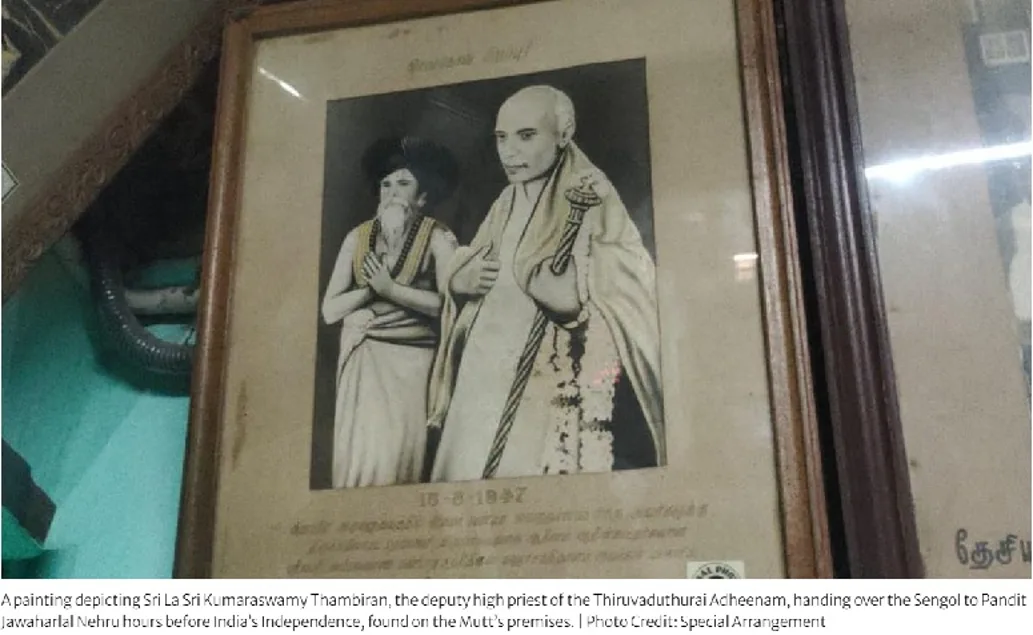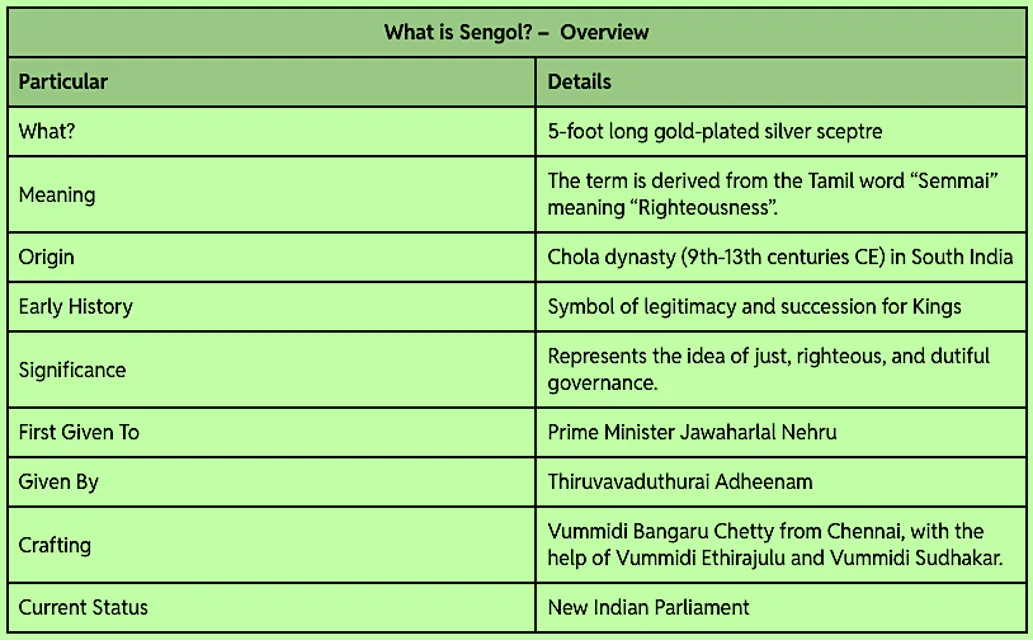What’s in this Article?
- Table of Contents
- Why in the news?
- What is Sengol?
- Who Design Sengol?
- What is Thiruvavaduthurai Adheenam?
- Historical Significance of Sengol
- How Did Sengol Become a Part of India’s Independence?
- Where is the Sengol currently?
- Why in news?
- Samajwadi Party MP RK Chaudhary stirred a row after he demanded that the Sengol, a historic sceptre, be replaced with the Constitution in the Lok Sabha, inviting backlash from the BJP and other NDA allies.
- In a letter to pro-tem Speaker Bhartruhari Mahtab, RK Chaudhary called Sengol an “anachronistic symbol of monarchy” in a democratic India.
- Explaining the rationale behind his demand, Chaudhary said, “Sengol means ‘Raj Dand’. It also means ‘Raja ka Danda’. After ending the princely order, the country became independent. Will the country be run by ‘Raja ka danda’ or the Constitution? I demand that Sengol be removed from Parliament to save the Constitution.”
- What is Sengol?
- Sengol, a magnificent gold-plated silver scepter (known as “ceṅkōl” in IAST), has been relocated to India’s New Parliament House, carrying with it a rich historical legacy.
- This precious artifact was initially presented to Jawaharlal Nehru, India’s first prime minister, as a gift from an Adheenam in Tamil Nadu on the historic day of August 14, 1947.
- For seven decades, Sengol was housed in the Allahabad Museum, witnessing the nation’s history.
- However, in 2023, it was placed in a new position of honor during the inauguration of the New Parliament House by Prime Minister Narendra Modi. This transition highlights Sengol’s enduring significance in India’s heritage.
- Who Design Sengol
- Vummidi Bangaru Chetty, a jeweler from Chennai, is the creative force behind the sengol.
- This unique, handcrafted scepter is about 5 feet (1.5 meters) long, with a top diameter of around 3 inches (76 millimeters) and a bottom diameter of 1 inch (25 millimeters).
- The scepter consists of a wooden staff covered in gold plating, and it is topped with a seated Nandi figure symbolizing justice and strength.
- Sengol Meaning
- The term “Sengol” originates from the Tamil word “semmai,” which means righteousness.
- This sceptre holds profound historical significance, symbolizing India’s struggle for independence and the transfer of power from British colonial rulers to the Indian people.
- On August 14, 1947, around 10:45 pm, Pandit Jawaharlal Nehru accepted the Sengol sceptre from the Adhinam of Tamil Nadu.
- This momentous event marked the pivotal shift of authority, signaling the end of British colonial rule and the beginning of a new era for India.
- Recognizing the historical importance of Sengol allows us to appreciate its deep significance in India’s path to independence.
- What is Thiruvavaduthurai Adheenam?
- About
- Thiruvavaduthurai Adheenam is a significant Shaiva monastic organization, or mutt, located in Tamil Nadu, India.
- Situated in the town of Dharmapuram in the Mayiladuthurai district, it is one of the oldest and most esteemed Adheenams in the Shaiva tradition.
- Established in the 10th century by the sage Tirugnanasambandar, one of the four main Nayanars (saints) of Shaivism, the Adheenam has a rich historical legacy.
- Features
- The primary mission of the Adheenam is to promote and preserve the teachings, rituals, and practices of Shaivism. It plays a crucial role in publishing Saivite literature, especially Thevaram and Tiruvasakam, along with their translations.
- The head of the Thiruvavaduthurai Adheenam, known as the “Adheenakarthar,” is regarded as a spiritual leader and guide for its followers.
- Historical Significance of Sengol
- The Sengol carries deep significance, originating from the Tamil word “Semmai,” which translates to “Righteousness.” Crafted from gold or silver and often adorned with precious stones, the Sengol sceptre was wielded by emperors during ceremonial events to symbolize their authority.
- It is closely linked with the Chola Empire, one of South India’s longest-reigning and most influential dynasties.
- The Cholas governed regions of Tamil Nadu, Kerala, Karnataka, Andhra Pradesh, Telangana, Odisha, and Sri Lanka from the 9th to 13th centuries CE.
- They were renowned for their military strength, maritime trade, administrative efficiency, cultural support, and temple architecture.
- The Cholas maintained a tradition where the Sengol sceptre was passed from one king to the next as a sign of succession and legitimacy, a ritual typically conducted by a high priest or guru who blessed the new king and bestowed upon him the Sengol.
- How Did Sengol Become a Part of India’s Independence?
- Before India gained independence from British rule in 1947, Viceroy Lord Mountbatten asked Jawaharlal Nehru, the soon-to-be Prime Minister, about the appropriate ceremony to symbolize the transfer of power.
- Nehru consulted Rajagopalachari, known as Rajaji, who later became the last Governor-General of India.
- Rajaji proposed adopting the Chola tradition of handing over the Sengol sceptre as a fitting ceremony, as it would reflect India’s ancient civilization, culture, and unity in diversity.
- Consequently, the Sengol sceptre was presented to Nehru by the Thiruvavaduthurai Adheenam, a 500-year-old Saivaite monastery, on August 14, 1947. T
- he golden sceptre, crafted by renowned Madras jeweller Vummidi Bangaru Chetty, features a hand-carved Nandi at the top, symbolizing unwavering justice.
- Where is the Sengol currently, and what is the reason for its installation in the new Parliament building?
- After receiving the Sengol sceptre in 1947, Nehru initially kept it at his residence in Delhi. He later decided to donate it to the Anand Bhavan Museum in Allahabad (now Prayagraj), which was his ancestral home.
- The museum, established by his father Motilal Nehru in 1930, aimed to preserve the history and legacy of India’s freedom movement. The Sengol sceptre remained at the Anand Bhavan Museum for over seventy years.
- In 2021-22, during the Central Vista redevelopment project, the government decided to commemorate this historical event by installing the Sengol sceptre in the new Parliament building.
- It has been placed near the Speaker’s seat, accompanied by a plaque explaining its history and significance.
The installation of the Sengol in the new Parliament building is more than a symbolic gesture; it conveys that India’s democracy is deeply rooted in its ancient traditions and values, emphasizing inclusivity and respect for diversity.
Disclaimer: The article may contain information pertaining to prior academic years; for further information, visit the exam’s “official or concerned website“.












